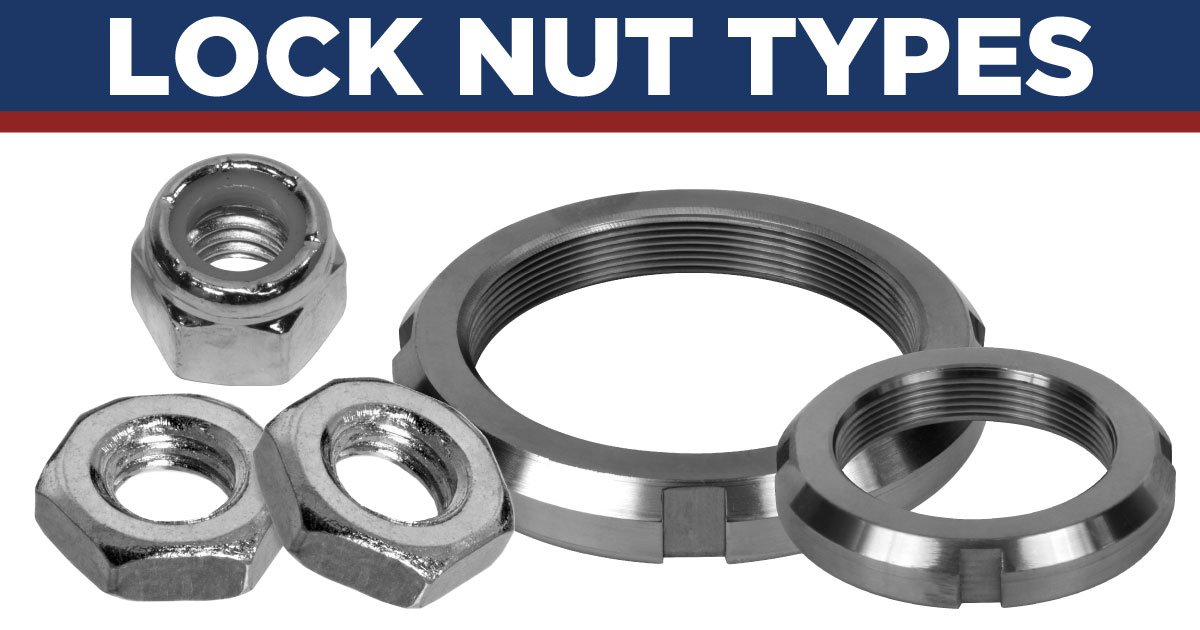- Huyett Marketing Department
- 06/03/2021
- Updated: 07/20/2023

Not all nuts are created equal. There are times when the need arises for a threaded fastener that offers increased resistance to loosening; lock nuts are frequently the go-to solution when an application will be exposed to significant motion or vibration.
What is a Locknut?
Lock nuts are an internally threaded fastener that either lock by themselves or in concert with another component. Lock nuts are engineered to resist loosening when subjected to vibration or torque.
What are the Different Types of Lock Nuts?
There are many types of lock nuts manufactured for a variety of purposes. We will focus on the most common types offered by Huyett. This includes lock nuts with nylon inserts, jam nuts, and bearing lock nuts.
Lock Nuts with Nylon Inserts
Lock nuts with nylon inserts (self-locking nut, locking nut), are a prevailing torque locking nut that resists loosening caused by vibration and normal use.
Prevailing Torque: The required torque to secure a locking nut onto the mating component’s threads.
Unlike
free spinning nuts, lock nuts feature a deforming elastic or metal material that fortifies the secured threaded position to resist torque and shock. Lock nuts with nylon inserts are a popular solution for many applications; however, they are limited to applications exposed to temperatures under 250°.

How Do Lock Nuts with Nylon Inserts Work?
Hex lock nuts use a nylon insert at the top of the nut, creating tension between the nut and the threads of the mating component. As the nut is threaded onto a shaft or rod, it will spin freely until the threads from the host part engage the nylon insert. The threads of the mating shaft will displace the nylon and create resistance. This resistance prevents unintentional moving of the lock nut.
The nylon in traditional hex lock nuts can wear and become less effective after repeated removal and installation. For optimum holding power, replace the nut if it needs to be removed during disassembly of a component.
Which Way Does a Lock Nut with a Nylon Insert Go?
Prevailing torque lock nuts are installed with the nylon locking end of the nut positioned at the bottom of the mating threads. When installing, the nut should thread on freely until the mating threads of the host component engage the nylon insert.
Can You Reuse Nylon Lock Nuts?
For safety reasons, it is not recommended to reuse a nylon lock nut because it loses prevailing torque with each use. Once a nylon lock nut is installed, the nylon insert is deformed; if you were to remove the nut and reinstall it, its locking strength would be lost.

Jam Nuts
Jam nuts, or half nuts, are a low-profile hex nut with a profile half the height of a standard hex nut. Jam nuts are used as a
locknut to prevent vibration from loosening a bolted joint. Before nuts were developed with self-locking capabilities, two jam nuts would be tightened against each other so that nuts wouldn’t loosen over time.

How Do Jam Nuts Work?
Jam nuts use opposing friction against either another jam nut or a standard hex nut to lock into position on a threaded shaft or rod. There are conflicting view points on which nut should be installed first, however the most common use case involves the jam nut being tightened down first. The jam nut is followed by the second nut which is tightened or “jammed” against the jam nut.
It is difficult to get both nuts properly torqued in this configuration, which makes it undesirable for critical applications where the assembly carries a tension load.

Bearing Lock Nuts
Bearing lock nuts, sometimes called shaft locknuts or bearing retaining nuts, secure bearings onto a shaft and prevent components from loosening due to vibration and rotation. Bearing locknuts possess a different appearance from traditional
hex lock nuts. Bearing locknuts are typically rounded on the outside with keyed slots. This design requires a special tool called a spanner wrench or socket to be installed or removed. Bearing locknuts are used in a wide variety of applications including the automotive and agriculture industries.

How Do Bearing Lock Nuts Work?
Bearing lock nuts require a positive locking action, similar to castellated nuts, to lock in place. Bearing lock nuts are mated with
bearing lock washers to achieve locking capabilities. The machined grooves in the face of the nut provide a mating surface for the tangs of the lock washer to fold into, locking both components in place.

How Do You Tighten a Lock Nut?
This is a commonly asked question; fortunately, there is a very simple answer: tighten a lock nut in the same manner you would tighten any other nut. Place the nut on the end of the bolt and tighten it with your hand. Once you can no longer turn the lock nut, use a wrench to tighten it to the required torque.
Huyett: Your Distributor for Lock Nuts and Industrial Fasteners
Follow our
blog page for more information about lock nuts as well as other products and services from Huyett. If you have questions about a product, visit our
FAQ pages or
give us a call to speak with our friendly, experienced Sales Team!

